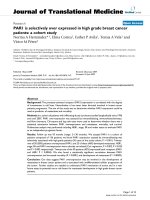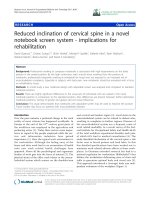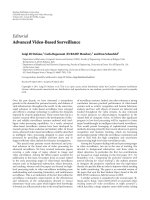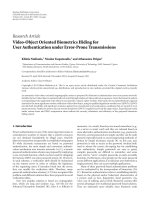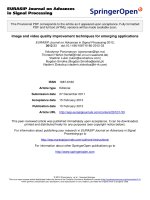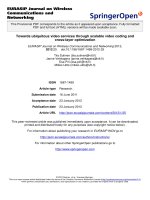Báo cáo hóa học: " Voice and Video Telephony Services in Smartphone Valeria Loscri’, Mauro Tropea, and Salvatore Marano" docx
Bạn đang xem bản rút gọn của tài liệu. Xem và tải ngay bản đầy đủ của tài liệu tại đây (826.33 KB, 8 trang )
Hindawi Publishing Corporation
EURASIP Journal on Wireless Communications and Networking
Volume 2006, Article ID 84945, Pages 1–8
DOI 10.1155/WCN/2006/84945
Voice and Video Telephony Services in Smartphone
Valeria Loscri’, Mauro Tropea, and Salvatore Marano
Department of Electronics, Informatics and Systems Department (DEIS), University of Calabria via P. Bucci,
42C, 87036 Arcavacata, Rende (CS), Italy
Received 3 August 2005; Revised 13 February 2006; Accepted 2 March 2006
Recommended for Publication by Fary Z. Ghassemlooy
Multimedia telephony is a delay-sensitive application. Packet losses, relatively less critical than delay, are allowed up to a certain
threshold. They represent the QoS constraints that have to be respected to guarantee the oper ation of the telephony service and
user satisfaction. In this work we introduce a new smartphone architecture characterized by two process levels called application
processor (AP) and mobile termination (MT), respectively. Here, they communicate through a serial channel. Moreover, we focus
our attention on two very important UMTS services: voice and video telephony. Through a simulation study the impact of voice
and video telephony is evaluated on the s tructure considered using the protocols known at this moment to realize voice and video
telephony.
Copyright © 2006 Valeria Loscri’ et al. This is an open access article distributed under the Creative Commons Attribution License,
which permits unrestricted use, distribution, and reproduction in any medium, provided the original work is properly cited.
1. INTRODUCTION
In the last few years, with the downturn of the new economy
and particularly the telecommunications sector, mobile op-
erators have been rethinking ways to deliver innovative and
cost-effective services by providing IP connectivity to every
mobile device. Moreover, new components and new mod-
ules have been created as smartphones. The latter are char-
acterized by an opportunistic choice of operating systems.
The more common operating systems developed for these
components are Windows Mobile, Linux Mobile,andabove
all Symbian. Moreover, other technologies have been stud-
ied to enable similar terminals to add the computer func-
tions to telephony functions [1, 2]. In this work we con-
sider an architecture implying the subdivision of the mod-
ules around the applications: the interface in a unique com-
ponent and telephony functions in another module. The two
modules (each equipped with its own processor) communi-
cate through a serial channel. The standard considered here
to have the serial communication is the RS-232 [3]. Specif-
ically, an extension to this last standard is considered, Eu-
ropean telecommunication standards institute (ETSI) 07.10.
The standards to support the multimedia telephony services
on a smartphone: H.300s, G.700s, H.260, T.120s [4]were
analyzed. Then in order to validate our approach, accurate
traffic models are described for simulations before present-
ing and analyzing simulation results.
2. MULTIMEDIA TELEPHONY ISSUES:
THE STATE OF THE ART
Multimedia telephony is a delay-sensitive application: an up-
per limit of 150 ms of end-to-end delay with low variation
must be ensured to guar a ntee the operation of the telephony
service and user satisfaction [5]. Packet losses, relatively less
critical than delay, are allowed up to a certain threshold since
they can be compensated by loss recovery mechanisms at the
codec level. For example, the G.729 codec with good voice
quality requires packet loss of less than 1 percent to avoid au-
dible errors [5]. The standards used to ensure the voice and
video telephony services are H.300s, G.700s, H.260s, T.120s.
These standards cover all the categories of coding-decoding.
The main video standards are
(i) H.261: video codec for audio-visual services
(64 Kbps);
(ii) H.263: video codec for telecommunications less than
64 Kbps.
Audio standards:
(i) G.711: pulse code modulation (PCM) for audio fre-
quencies, use a B channel 64 Kbps;
(ii) G.722: 7 KHz for audio codified to 64 Kbps;
(iii) G.723.1: dual rate speech codec for telecommunica-
tions to 6.4 Kbps and 5.3 Kbps;
(iv) G.728: codec a 16 Kbps with small delay using linear
prediction.
2 EURASIP Journal on Wireless Communications and Networking
Data standards:
(i) T.120: protocols and services for multipoint Data con-
ferencing.
Video window sizes:
(i) NTSC—National Television Standards Committee,
used in USA, Canada, and Japan. 640
× 480 pixels;
(ii) PAL—phase alternation by Line, used in Europe,
Africa, and the Middle East. 768
× 576 pixels;
(iii) SECAM—sequentielle couleur avec memoire, used in
France and Russia;
(iv) CIF—common interchange format; optional with
H.261, 352
× 288 pixels;
(v) QCIF—quarter common interchange format; used
with the standard H.261, 176
× 144 pixels.
The H.323 contains the audio, v ideo, and data specifi-
cations a pplied to every telephony system. Examples are ex-
plained as follows:
(i) integra ted digital service network (ISDN): H.320 in-
cluding: Video: H.261; Audio: G.711, G.722, G.728;
Data: T.120;
(ii) local area network (LAN): H.323 including: Video:
H.261; Audio: G.711, G.722, G.723, G.728; Data:
T.120;
(iii) public switched telephone network (PSTN): H.324 in-
cluding: Video: H.263; Audio: G.723.1; Data: T.120;
(iv) internet: H.323 including: Video: H.263; Audio: G.723;
Data: T.120.
Specifically, attention is focused on the ITU standard H.324
[6] describing multimedia terminals operating over PSTN
(public switched telephone network). This is the point for the
evolution of the new standard supporting video telephony
services over mobile terminals [7].
3. PROPOSED ARCHITECTURE OF SMARTPHONE
In this work, a new type of smartphone characterized by
a network interface GSM/GPRS/EDGE/UMTS, based on an
architecture with two processors is considered. A discrete
event-driven simulator was realized to evaluate the perfor-
mances of the multimedia services on our smartphone. A
simplified version of our terminal is shown in Figure 1.Two
processors can be distinguished called, respectively, AP (ap-
plication processor)andMT(mobile termination). A platform
based on the GNU/Linux system was considered. In Figure 1
note how the AP and the MT are linked.
Two different operating systems are considered for the
mobile equipment (ME) and the terminal equipme n t (TE).
They are equipped with two different processors and the
physical link is a serial channel. It is clear that ME and AP
represent the same module, the application processor and TE
or MT identify the mobile termination.TheWTM(wire-
less telephony manager) is the software module that per-
mits communication between the application layer and the
mobile termination (the serial channel mentioned above).
Through the WTM module it is possible that applications
running on a mobile terminal communicate with other re-
mote applications through an available network communi-
cation(GSM/GPRS/EDGE/UMTS/Bluetooth ).TheWTM
has to manage the traffic and the resources available in the
MT module. This is because the applications considered
above can be concurrent. The WTM was designed as a versa-
tile module permitting different types of communications to
be managed through standard protocols (TCP/IP) or other
types of protocols (files, data-streams, etc.).
Between the two modules AP and MT there are different
types of interfaces:
(i) AT commands (standard and nonstandard)
(ii) interprocessors c ommunication (IPC) through a multi-
plex serial protocol based on 3GPP TS 07.10 standard.
The latter solution to design our terminal was chosen. In
this way, through the standard 3GPP TS 07.10, communi-
cation between AP and MT modules can be obtained. This
standard permits some number of sessions over an asyn-
chronous serial channel to be established. Each session can
be used to transfer data, voice, fax, SMS, GPRS, and so forth.
In this way it is possible to execute different applications si-
multaneously. Naturally the multiplexer protocol is not de-
pendent on the specific AP and MT modules and it is de-
signed for mobile terminals with a battery and for this rea-
son it is equipped with power saving functions. The multi-
plexer protocol is charac terized by different types of func-
tionalities:
(i) base;
(ii) advance without error recovery;
(iii) advance with error recovery.
Thefirstoptionwaschosenforconsideration.Thisisdue
to the specific charac teristics of the ser ial link considered in
this work. In effect it is a simple physical serial channel and
for this reason it is not necessary to consider error recovery.
Through the use of the standard 3GPP TS 07.10 it is possi-
ble to have a virtualization of the serial channel. In fact, it is
based on some number of virtual channels called data link
connection (DLC). The standard does not specify the num-
ber of channels that has to be opened. In fact, in the standard
it is only specified that the total number of channels must be
greater than 63 and the 0 channel is a specific channel defined
as control channel. Channels 1–7 have the same priority. An
application was associated with each channel. Examples of
applications are
(i) SMS,
(ii) voice call,
(iii) GPRS data connections,
(iv) UMTS data connections,
(v) video Call (UMTS).
Based on these considerations we chose to consider 5
channels and the control channel. Hence, 6 channels were
considered in all. In this work attention is focused on the
specific traffic generated by a video calling and the perfor-
mances of our smartphone considering this specific service
will be evaluated.
Valeria Loscri’ et al. 3
Terminal equipment (MT)
Application 1 Application 2
···
WT API
Messages
WT API
Events
Messages
WT API
Messages
Messages
WTM
API AT commands
Responses Notifications Responses Notifications
IPC
AP AT
Mobile equipment (AP)
Linux user space
Linux kernel
Figure 1: AP and MT.
4. VIDEO CALL ON S MARTPHONE
4.1. Overview
The video telephony service is characterized by delay require-
ments similar to those of voice services; due to the nature
of the video compression BER requirements are more con-
straining than that of the voice. Specific UMTS have pro-
vided for video telephony services on a c ircuit switched con-
nection where they have to use the ITU-T recommendations.
H.324M or, as called by the 3GPP, 3G-324M [4]. It is a spe-
cific case of the H.324 version that follows the annexed C.
This recommendation covers the technical requirements for
very low bit-rate multimedia telephone terminals operating
over the general switched telephone network (GSTN).
H.324 terminals provide real-time video, audio, or data.
The multimedia telephone terminals defined in this recom-
mendation can be integrated into PCs or workstations, or be
stand-alone units.
The terminal user specified from this standard has the
structure as shown in Figure 2.
The general structure of the system is very similar to that
of the original standard (H.324) [6]. Substantial differences
are present in the specific component use in order to fulfill
every base function.
The annex C of the H.324 standard describes specific is-
sues to allow the use of H.324 terminals in error-prone trans-
mission environments. These issues include sp ecific options
for H.324 terminals:
(i) the mandatory use of NSRP (numbered simple re-
transmission protocol);
(ii) the use of robust versions of the terminal multiplexer;
(iii) procedure for level set-up;
(iv) procedure for dynamic change between levels during a
session.
The 3GPP standard defines the UMTS/WCDMA require-
ments and also the stru cture and implementation of the 3G-
324M standard as defined in TS 26.111 [8].
The network 3G-324M components include end-point,
cellular terminals or PDA wireless terminal, base stations that
support the circuit switched services and gateway that per-
mit the interaction with the Internet network and a server
that p ermits the supply to multimedia services on demand.
The 3G-324M requirements that use the circuit switched
4 EURASIP Journal on Wireless Communications and Networking
Video I/O
Audio I/O
Data apps
System
Video codecs
H.263 (MPEG-4)
Audio codecs
GSM-AMR
(G.723.1)
Data sharing
protocols (such as
the T.120 series)
Command and
control H.245
with NSRP and
CCSRL
Multiplexer/
demultiplexer
H.223
with annexes
AandB
Transparent
synchronous link
(64 Kbps typical)
3G
modem
Call control
for 3GPP
TS 26.112
TS 24.008
TS 27.007
Figure 2: 3G-324M system diagram.
network allow multimedia conversational services with de-
lay sensibility to be obtained, such as “video conferencing
for personal and business use,” “multimedia entertainment
services,” telemedical services, Surveillance, live video broad-
casting and Video-on-demand (movies, news clips), besides
the normal video call.
An appropriate interface has to be implemented so that
a terminal can be interfaced with the external network. The
UMTS/WCDMA network provides for the use of a specific
UMTS modem that works with specific commands allowing
multimedia applications to be set up and used. 3GPP defines
a set of AT commands [9] that are used to set and manage
the modem over 3G-324M terminals.
After a connection is successfully established then a com-
munication channel for data which will travel to 64 kbps will
be used. The call set-up is a time that the user must wait to
have an audio-video connection.
Fundamental operations that a video call have to follow
areasfollows.
Audio-video transmission:
(i) acquisition from video camera,
(ii) codify video with H.263 encoder,
(iii) codify audio with G.723.1 or ARM encoder,
(iv) multiplexing audio/video H.223,
(v) H.245 (to do controls),
(vi) adaptation to UMTS network target for transmission
to the outside,
(vii) framing 07.10 for s ending on serial channel.
Audio video reception:
(i) 07.10 “unpacking,”
(ii) GSM/GPRS/EDGE “unpacking,”
(iii) Audio/video demultiplexing,
(iv) H.263 decoding,
(v) audio decoding,
(vi) dimension display scaling, color conversion e RGB16
packeting,
(vii) display on LCD.
4.2. Video codec
QCIF is an image format adapted to videoconference which
has an acquisition bit rate that can vary from 10 to 30 frames
per second (fps). The dimension in pixel is 144
× 176. These
requirements, in agreement w ith ITU H.263 standard, are
used commonly for the video codec that have to be trans-
mitted on a channel with a bandwidth inferior to 64 Kbps.
The QCIF is correlated to CIF (common intermediate for-
mat) because it represents a quarter of it, in fact, the CIF pix-
els are 288
× 352. The encoding is operated on an intraframe
and interframe. The interframes are those images that are
correlated to the previous ones, in particular they contain in-
formation only on the image differences with precedent im-
ages and then it is impossible to decode these images with-
out, beforehand, having decoded the previous images. The
intraframe, instead, can be decoded without the need for
outside information.
CIF and QCIF images are subdivided into blocks, mac-
roblocks, group of blocks, and complete images. Every block
isformedfromasquareof8
× 8 pixel and every macroblock
(MB) is formed from four blocks, therefore it is a square
with a side of 16 pixels. Generally, these are luminance pix-
els. For every four luminance pixels there are a CB pixel and a
CR pixel, then a macroblock is formed from four luminance
blocks and one of chrominance CB and one of chrominance
CR. Every group of blocks (GOB) is formed from 3
× 11 mac-
roblocks, for w h ich reason, it can finally be asserted that an
image in CIF (352
× 288) format is composed of 12 GOB and
one QCIF (176
× 144) from 3 GOB.
4.3. Audio codec
The audio codec represents an irreplaceable manner for the
transmission and the computing of any audio signal, from a
simple vocal signal to a complex musical one.
The H.324 standard previews the support to the audio
codec G.723.1 [10] which permits the encoder and decoder
audio to 5.3 Kbps and 6.3 Kbps.
Valeria Loscri’ et al. 5
Multiplexer
Aggregated
traffic
Heterogeneous
traffic
flows
Exit
link
Figure 3: Markovian overlapping.
Bit rate
Audio
Video
t
Figure 4: Audio and video traffic data overlapping.
The UMTS codec adopts a technique called AMR (adap-
tive multirate) [11]. The vocal encoder is a single vocal en-
coder integrated with eight possible speed of source: 12.2,
10.2, 7.95, 7.40, 5.90, 5.15, and 4.75 Kbps. The AMR bit rate
is controlled from the radio access network and does not de-
pend on the source activity. In order to make interoperabil-
ity easy with the existing cellular networks, some speeds are
equal to those already present in the networks before UMTS.
ThevocalencoderAMRswitchesitsownbitrateevery20ms
of vocal frame.
The connection vocal AMR bit rate can be controlled
from the network access as a function of the radio interfer-
ence and vocal connection quality. For example, it is possi-
ble to use an inferior bit rate, during traffic peaks, like high
traffichours,soastooffer greater contemporary connection
capability despite slightly inferior vocal quality.
5. SIMULATION RESULTS
The video call on the serial channel was simulated through
the construction of an ad hoc simulator. The tests were con-
ducted considering a number of applications running simul-
taneously on the smartphone for estimating the worst case
of the serial channel. The multitasking on the serial chan-
nel is possible using the ETSI GSM 07.10 protocol. Video call
simulation is difficult for the heterogeneity of the traffic; in
fact, in our experiments, two different types of trafficarepre-
sented: a udio and video traffic.
The first one is modeled with an ON/OFF model; instead,
the second one is characterized by a great variability of bit
rate without silence moment like in the audio traffic. This
variability is, in effect, considered constant because the video
call reserves a fixed bandwidth of 64 kbps for the entire call
duration.
The maximum dimension of the package that comes out-
side from multiplexer H.223 [12] is 254 with maximum of
4 bytes of the header.
In our simulations two different scenarios were consid-
ered:
(i) fixed dimension of package. The simulation of this
traffic is performed in order to consider the worst case
for the serial channel performance;
(ii) variable dimension of package. An algorithm is imple-
mented that creates a package with a dimension that
goes from 100 bytes to 254 bytes.
The parameters considered for the performance evalua-
tions are as follows.
(i) Serial channel bandwidth occupation: it is calculated
as the number of bits inside the channel buffer.
(ii) Number of packet loss: it is calculated as the number
of packets that is not possible to put inside the buffer.
(iii) Transmission overhead: it is calculated as the overhead
introduced by the 07.10 protocol for transporting the
information.
5.1. System model
It is very hard to generate traffic that well simulates a video
calling, because the data represented are very heterogeneous.
This heterogeneity is well represented by Figure 3.
In our simulation we considered Markovian overlapping
in which two different kinds of traffic, video, and audio, with
different bit rates, are overlapped. In Figure 4 the overlapping
is shown.
The audio was modeled as an ON-OFF [13]sourcetraf-
fic, vice versa the video cannot be modeled in this way
because there is a continuously bit rate variation and the
transmission does not have silent moments as in the audio.
Also, if there is a variability of the bit rate, since the video
calling sets a bandwidth to 64 kbps in circuit switching, the
total traffic will be a constant bit rate. The maximum di-
mension of packet is constant and it is fixed through the
multiplexer H.223 and it is 254 bytes with a maximum of
4 bytes of header; the traffic can be simulated in two different
ways.
6 EURASIP Journal on Wireless Communications and Networking
Table 1: Simulation parameters.
Simulation parameters
First campaign
Channel velocity (kbps) 57.6, 115.2, 230.4
Videocallduration(s)
120, 240, 360, 720
Packet dimension (bytes)
258
Second campaign
Channel velocity (kbps) 57.6, 115.2, 230.4
Videocallduration(s)
120 (da webcam)
Packet dimension (bytes)
Variable (100–258)
(i) Fixed dimension packet
The dimension of the packet is maintained fixed based on
the dimension of the multiplexer H.223. This dimension has
been fixed as the maximum dimension of the packet. This as-
sumption is not realistic because this signifies that there are
continuous and rapid scene changes and consequently con-
tinuously coding within the audio codifier that overcharges
the packet. In terms of simulation it is interesting to evaluate
it because we consider the worst case channel condition. In
practice, this kind of traffic generation is implemented allo-
cating the necessary bandwidth permitting 258 bytes of traf-
fic to pass on the serial channel with a bit rate of 64 kbps.
(ii) Variable dimension packet
In order to generate this traffic a 3GPP file was generated.
Audio and video dimension frames were extracted from this
file and they were used as input of the serial channel in our
simulator.
Audio and video data traffic were evaluated together in
terms of bandwidth occupation, overhead, and so forth, be-
cause the main objective in this work is to establish the cor-
rect dimensioning of the buffer of the serial channel to per-
mit the video calling to work well in a similar structure as
considered above. The correct dimensioning of the channel
and the simulation of the video calling data trafficpermita
data transfer to be realized with a delay that is represented
only from the propagating delay on the data channel. In fact,
it cannot introduce another kind of delay for this kind of traf-
fic, otherwise the same structure c annot be considered to re-
alize a similar device.
5.2. First simulation modality
In the first simulation type a set of video calls are simulated
that are generated w ith a fixed packet dimension. The simu-
lation parameters are shown in Ta ble 1.
It is interesting to study the video call channel bandwidth
occupation (Figure 5). It is possible to observe an increase
of occupied bandwidth with the increase of channel speed.
This is observed for all the durations considered. Here only
the case of a duration of 120 seconds is shown, because the
0
10
20
30
40
50
60
70
×10
3
Bandwidth (bit)
57600 115200 230400
Channel rate (bps)
Figure 5: Bandwidth variation TX (120 sec.).
0
1000
2000
3000
4000
5000
6000
Lost packets
57600 115200 230400
Channel rate (bps)
Lost packet 120 s
Lost packet 240 s
Lost packet 360 s
Lost packet 720 s
Figure 6: Packet Loss for different rate values.
graphic slope is equal also for the duration of 240, 360, and
720 s.
Figure 6 shows the packet loss for different types of chan-
nel speed and different video call durations. In this case it is
possible to observe that for the velocity of 57.6 kbps the sys-
tem presents a packet loss that has been calculated at about
2% with respect to the overall packet sent in the channel. This
is due to an inferior channel speed versus the standard speed
for this type of application in an UMTS networks of 64 kbps.
Then,forthechannelrateof57.6kbpsitisnormaltoob-
serve a little loss. Instead, in the other cases, as it is possible
to observe in the graphic, the packet loss is zero, because the
channel speed is greater than UMTS speed channel.
Valeria Loscri’ et al. 7
2.6
2.65
2.7
2.75
2.8
2.85
2.9
Overhead (%)
57600 115200 230400
Channel rate (bps)
Overhead 120 s
Overhead 240 s
Overhead 360 s
Overhead 720 s
Figure 7: Overhead (%).
536
538
540
542
544
546
548
550
×10
2
Bandwidth occupation (bit)
57600 115200 230400
Channel rate (bps)
Bandwidth TX
Bandwidth RX
Figure 8: Bandwidth variation for different rate values.
In Figure 7 the overhead introduced owing to the effect
of the packetization can be observed. In practice the protocol
07.10 introduces some overheads into the serial channel to
transfer data from AP to MT and vice versa. This overhead
has to be taken into account and it is
≈ 3 % of overhead for
eachpacket.Inthisway,wehave7controlbytesfor258data
bytes; we can conclude that it is an acceptable overhead.
0
1000
2000
3000
4000
5000
6000
7000
Overhead (%)
57600 115200 230400
Channel rate (bps)
Overhead Tx camp. I (%)
Overhead Rx camp. I (%)
Overhead Tx camp. II (%)
Overhead Rx camp. II (%)
Figure 9: Campaign I versus campaign II overhead comparison.
5.3. Second simulation modality
In this second campaign traffic generation with variable
packets was used. The scope of this simulation campaign is
to show the same simulation parameters, like that in the first
campaign, randomly varying the packets dimension. This
type of scenario is more realistic than the first one consid-
ered above. It shows the behavior of a terminal that perform s
a video call, as known through a 3GPP software tool. This
tool showed that for a video call a bandwidth of 49.5 kbps is
sufficient, which is a smaller velocity than that of the UMTS
standard.
It is interesting first of all to see the slope of the total
bandwidth on the channel.
The bandwidth occupation is constant for different ve-
locity values, but it is saturated for rates of 57.6 kbps. This
means that it is a limit velocity and that only thanks to the
buffer dimensioning there is no packet loss (Figure 8). In this
case the channel is strongly stressed. It can be seen that, in
this second campaign, there is an increase of the overhead in
respect to the first campaign. As can be seen from the graphic
it is approximately doubled (Figure 9). This shows a consid-
erable increase of the resource waste. This is due to the packet
variable dimension.
Then, it can be concluded that to have a packet with a
constant dimension it is useful in terms of waste, but unfor-
tunately is not very realistic.
A true video call generates a set of variable packets, then
it is unforeseeable to know how much bandwidth waste there
will be on the channel. This leads to the decision of giving a
8 EURASIP Journal on Wireless Communications and Networking
sufficient bandwidth to the application. From the study car-
ried out it seems that a bandwidth of 115.2 kbps is the band-
width deputed for performing video calls on a smartphone
terminal.
6. CONCLUSIONS
The study performed in this paper points out what are the
specific features of a video call, generating a traffic that can
simulate the real behavior of this type of application over
smartphone terminals. It is useful to emphasize how the video
call is not still an optimized service. In fact, it travels on a cir-
cuit switched connection and this leads to some difficulties
like a fixed bandwidth al l ocation, with the problem of waste
and a slowness in v ideo audio synchronization. The charac-
teristic parameters of the video call have been taken into con-
sideration in traffic generation. The main information that
characterizes this service is a fixed bit ra te of 64 kbps, but the
typical video traffic, as we have seen, is highly variable, since
a great part of the weight of the packets is given from the data
video codified with H.263.
ACKNOWLEDGMENT
This work was supported in part by the Enteos Mobile Busi-
ness Society of Trieste (Italy).
REFERENCES
[1] R. B. Ali, S. Pier re, and Y. Lemieux, “UMTS-to-IP QoS map-
ping for voice and video telephony services,” IEEE Network,
vol. 19, no. 2, pp. 26–32, 2005.
[2] I. Maniatis, G. Nikolouzou, and S. Venieris, “QoS issues in the
converged 3G wireless and wired networks,” IEEE Communi-
cations Magazine, vol. 40, no. 8, pp. 44–53, 2002.
[3] />Com Basics/
RS232
standard.html.
[4] 3GPP TS 26.110, “Codec for circuit switched multimedia tele-
phony service; General description”.
[5] Cisco Systems, “Quality of Service for VoIP,” 2001, http://www.
cisco.com/universcd/cc/td/doc/cisintwk/qossol/qosvoip.pdf.
[6] ITU-T H.324 Series H, “Audio Visual and Multimedia Sys-
tem Infrastructure of audiovisual service—System and termi-
nal equipment for audiovisual service. Terminal for low bit
rate multimedia communication”.
[7] UMTS 22.72 v 0.0.0 (1999-01), “Universal Mobile Telecom-
munications System (UMTS); Real-time Multimedia in
UMTS”.
[8] 3rd Generation Partenership Project, “Technical Specication
Group Service and System Aspect; code for circuit switched
multimedia telephony service; modifications to H.324”.
[9] ETSI TS 127007 v 3.12.0 (2002-12), “Digital Cellular Commu-
nications System (Phase2+); Universal Mobile Telecommuni-
cation System (UMTS)”.
[10] />[11] 3G TS 26.071 v 3.0.1 (1999-08), “3
rd
Generation Partnership
Project; Technical Specification Group Service and System As-
pects; mandatory speech codec speech processing functions
AMR speech codec; General Descr iption (3G TS 26.071 v
3.0.1)”.
[12] ITU-T Reccomendation H.223, “Multoplexing Protocol for
low bit rate multomedia communication”.
[13] P. T. Brady, “A model for generating on/off speech patterns in
two way conversations,” Bell System Technical Journal, vol. 48,
1969.
Valeria Loscri received t he degree in com-
puter engineering from University of Cal-
abria, Italy, in 2003, she has been with the
telecommunications research group of the
University of Calabria where she is fully in-
volved in a number of projects concerning
the multimedia wireless communications.
She is currently working toward the Ph.D.
degree in the Telecommunication Labora-
tory, Department of Electronics, Informat-
ics and Systems (DEIS). Her research interests include quality of
service, and m edium-access control, performance analysis, ad hoc
networks, and wireless sensors networks.
Mauro Tropea graduated in computer en-
gineering at the University of Calabria,
Italy, in 2003. Since 2003 he has been with
the Telecommunications Research Group of
DEIS in the University of Calabria. In 2004,
he won a regional scholarship on satellite
and terrestrial broadband digital telecom-
munication systems. Since November 2005
he has been a Ph.D. student in electron-
ics and communications engineering at the
University of Calabria. His research interests include satellite com-
munication networks, QoS architectures and interworking wireless
and wired networks, mobility model.
Salvatore Marano graduated in electronics
engineering at University of Rome in 1973.
In 1974 he joined the Fondazione Ugo Bor-
doni. Between 1976 and 1977, he worked at
ITT Laboratory in Leeds, United Kingdom.
Between 1977 and 1979 he was with Face
Standard Central Laboratory in Pomezia
(Rome). Since 1979 He has been an Asso-
ciate Professor at the University of Calabria,
Italy. His research interests include perfor-
mance evaluation in mobile communication systems, enhanced
wireless and satellite systems, personal communications systems.
